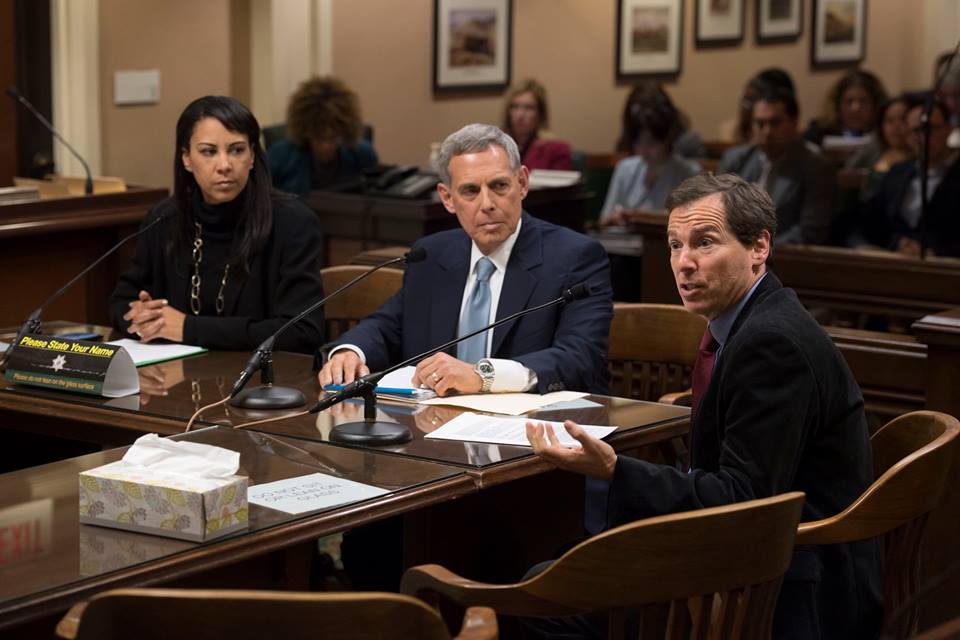Applying Science to Solve Poverty: CA’s AB 1520
Share this page:
By David Grusky, Ph.D, Professor of Sociology, Stanford University; Director, Stanford Center on Poverty & Inequality (Above, Professor Grusky testifies at an April hearing for AB 1520)
May 2017 – When a highway bridge collapses in California, as one recently did in Big Sur, there’s no paralyzing legislative debate about whether to fix it, how to fix it, or even when to fix it. We just fix it.
So here’s a puzzle: Why don’t we also “just fix it” when it comes to repairing California’s poverty problem? It’s beyond debate, just to be clear, that California does have a massive poverty problem: The best available measure, the California Poverty Measure, puts the overall poverty rate at 20.6 percent and the child poverty rate at 23.1 percent.
Why has California, the land of plenty, evidently decided that it’s just fine to have one of the country’s highest poverty rates? Here’s the main reason: It’s widely believed that we just don’t know how to take on poverty. We’re quick to fix the bridge because at least we know how to fix it. But poverty, by contrast, is seen as too complicated to remedy.
This view, however widespread it may be, confuses effects with causes. It’s quite right that the effects of poverty are complicated: These effects show up, for example, as health problems, cognitive problems, education problems, crime problems, marital problems, and labor market problems. It’s a massive, complicated, and unending job to treat the effects of poverty. It’s like plugging holes in a dam.
But the causes of poverty are, by contrast, comparatively simple and well understood. In recent decades, we’ve seen major advances in the science of poverty, advances that now make it possible — for the first time — to treat poverty at its source and reduce it permanently. This new science of poverty identifies the major turning points and junctures in a child’s life and identifies the interventions at each juncture that have been proven to work. When these interventions are knitted together into a comprehensive plan, they have a powerfully cumulative effect. The key features of this new science — and how it might be applied to reduce poverty in California — have been laid out in a recent report issued by the Stanford Center on Poverty and Inequality.
When poverty is treated at its source, the safety net becomes a sacred institution for restoring the American Dream. It’s not about charity. It’s about recommitting us to the principle that opportunity shouldn’t be put on the market and sold only to parents who have the money to buy it for their children.
But we can’t restore the American Dream with reports, science, and research alone. We also need good law. The latter comes in the form of AB 1520, the Lifting Children and Families Out of Poverty Act of 2017, authored by Assemblywoman Autumn Burke (D-Inglewood). This bill mandates that California move into the 21st century by building an anti-poverty response based on the new science of poverty. It mandates that our response must reduce child poverty by 50 percent over 20 years. And it mandates that we rigorously evaluate our progress toward that goal.
We of course don’t know how to do all this perfectly. But that shouldn’t paralyze us. We can continuously monitor the effectiveness of our interventions to assess what’s working and to reform our interventions in response to unforeseen results or new developments in science. The simple upshot: We can — and should — get started now and then continuously improve our response over time.
We thus have one of those rare opportunities to take control of California’s future and stand up for our children, expose the state’s lip-service commitment to equal opportunity, and to make it clear that — at least in California — we’ll make our commitment to equal opportunity a real and authentic one.
***
Find out more about the Stanford Center on Poverty and Inequality here.
Read the bill text for AB 1520 here.
